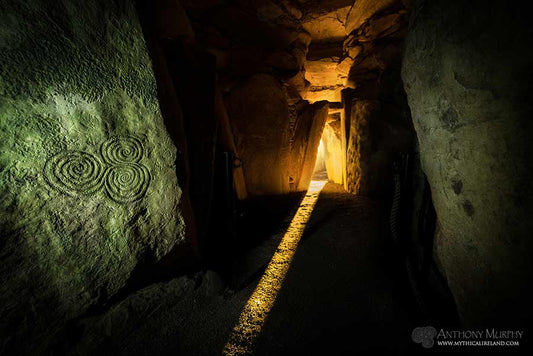
Another cropmark discovery at Newgrange Farm: Gateway to another world
In April of 2022, I made a further discovery at Newgrange Farm. I photographed crop marks that had appeared unexpectedly in two of the fields there, one of which I had imaged previously in the summer drought of 2018 and the spring drought of 2020.
On 2nd April 2022, while flying my drone over Newgrange Farm, I spotted a very interesting feature in crop marks that had not been seen previously.
The feature consists of what looks like two squares formed of pits or post holes. The fascinating thing about the feature is that it sits on the axis of a feature initially discovered by Ken Williams and I in 2018 and later discussed in detail by the National Monuments Service, called the "Great Palisade".
A giant fence
Think of the Great Palisade as a sort of gigantic "fence", made of huge posts, stretching across a span of 900 metres and forming a manmade barrier of sorts between the henge monuments on the lower terraces of the Boyne floodplain at Brú na Bóinne and the mortuary enclosures on the higher terrace. Archaeologist Dr. Steve Davis of University College Dublin estimates that there are around 4,000 post holes in the Great Palisade.
This "new" feature could well have been a large gate, allowing access between the different monument zones. Surprisingly, it was not visible in the 2018 imagery, when unprecedented dry conditions led to my discovery of Dronehenge and (with Ken Williams and NMS) a raft of other previously unknown archaeological features.

'Gateway' feature in the Great Palisade at Newgrange discovered by Anthony Murphy of Mythical Ireland.
The second image shows the location of this "gate" feature in relation to the Newgrange passage-tomb. The third image, a vertical panorama taken by me at the end of the spring drought in 2020, is annotated, showing the two "fences" of the Great Palisade, and the location of the "gate", which back then was only barely visible but had not yet been identified as an archaeological feature.

Annotated panoramic drone image showing Great Palisade and 'gateway' feature. © Anthony Murphy/www.mythicalireland.com
This is very exciting, because it demonstrates that despite the unprecedented once-in-a-generation drought crop marks of 2018, it is still possible to find more "new" (undiscovered) archaeology through continuous monitoring. The fact that I live just 10 minutes' drive from Newgrange Farm is hugely beneficial, and means that I can carry out regular drone surveys of the Brú na Bóinne landscape.
To get an idea of why this "gate" might be significant in terms of the different "zones" of monuments, watch this video shot at the Megalithomania in Glastonbury in 2019 in which I explained my theory about these zones.
In my home town of Drogheda, there is a famous monument called Laurence's Gate (photo below). I grew up in view of that great barbican, which was built by the Anglo-Normans when they walled the town in the late 12th and early 13th centuries. I like to think that perhaps the newly discovered feature at Newgrange Farm might have been a Late Neolithic equivalent of Laurence's Gate!

Laurence Gate in Drogheda, a 12th/13th century Norman era barbican.
NOTE: This article about the discovery of the 'gateway' was first shared with Mythical Ireland patrons in April of 2022. Become a patron to get early and exclusive access to photographs, videos, podcasts, articles, merchandise and more.









